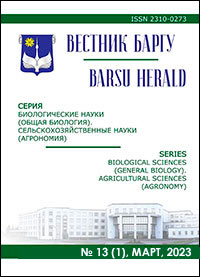APIACEAE AS LARVAL HOST PLANTS OF TUMBLING FLOWER BEETLES(COLEOPTERA: MORDELLIDAE)
Keywords:
Mordellidae; Apiaceae; larval morphology; ecology; anatomy of plantsAbstract
It is obvious, that due to the content of essential oils with insecticidal properties a small number of species of
tumbling flower beetles develop in plants of this family. The most significant anatomical features of Apiaceae as larval
host plants of tumbling flower beetles have been established. Using Mordellistena falsoparvula Ermisch, 1956 as
an example, it has been shown that larvae colonize biennials, which are in the second year of their life. In the stem
they feed on parenchyma cells of pith. In the main root the larvae mainly feed on xylem formed in the first year of the
plant’s life, which is rich in the storage parenchyma cells, as well as parenchyma cells of radial rays that adjoin it.
Damage to the root in the xylem zone formed in the second year of the plant’s life is insignificant. In the main root the
larvae often also feed on the phloem and the cells of radial parenchyma rays located in its zone. The studied plants are
divided into three groups: with pith-filled stems, with pith cavity in the internodes and with additional vascular bundles.
The larvae of M. falsoparvula were found on the territory of Belarus in three plant species: Torilis japonica
(Houtt.) DC., Daucus carota L. (plants of the first group) and Pastinaca sylvestris Mill. (second group of plants).
The first species is reported as a larval host plant of M. falsoparvula for the first time. It is noted that there are no external
signs of damage to plants inhabited by the larvae of tumbling flower beetles. According to feeding specialization
at the larval stage, M. falsoparvula belongs to oligophagous.
Fig. 17. Ref.: 12 titles.
Downloads
Published
Issue
Section
License
Copyright (c) 2023 Вестник БарГУ Серия "Биологические науки. Сельскохозяйственные науки"
Это произведение доступно по лицензии Creative Commons «Attribution-NonCommercial» («Атрибуция — Некоммерческое использование») 4.0 Всемирная.
Авторы сохраняют за собой право заключать определенные договорные соглашения, касающиеся неисключительного распространения опубликованной версии работы (например, размещать ее в институциональном репозитории, публикация в книге) со ссылкой на ее первоначальную публикацию в этом журнале.





